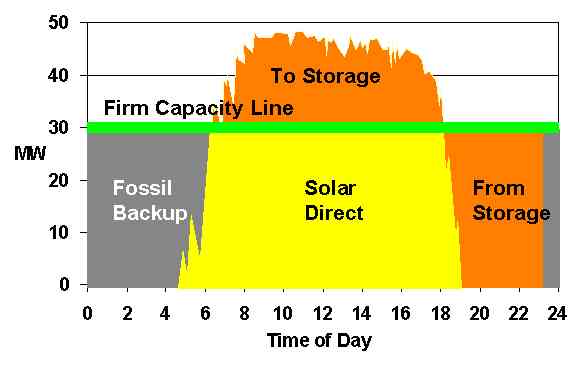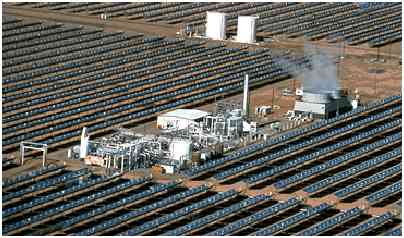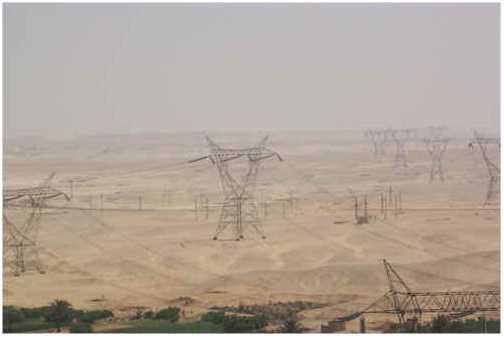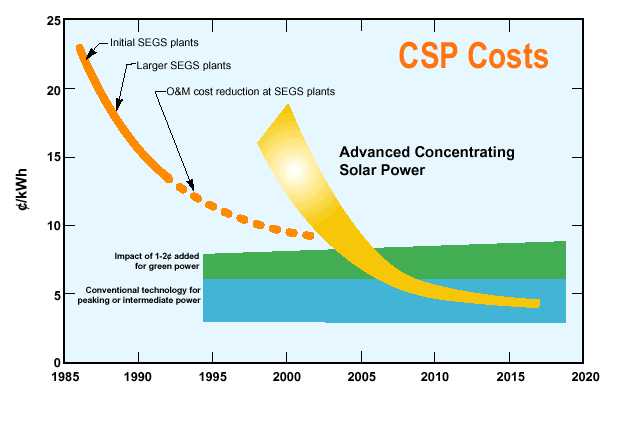William B. Stine, Michael Geyer
Continuation
1.4 Need for Storage
Like with any other power plant, solar power plant output must satisfy the demands of the utility market. During peak demand periods, kilowatt-hour prices are high and financial incentives are high for guaranteed supply. Solar plant input is limited by diurnal, seasonal and weather-related insolation changes. In order to cope with these fluctuations, the solar plant input may be backed up by fossil fuels, or the solar changes may be mitigated by a buffering storage system. The choice depends on demands, system and site conditions, The relationship between storage capacity and collector area is discussed in Chapter 10.
In thermal solar power plants, thermal storage and/or fossil backup act as:
- an output management tool to prolong operation after sunset, to shift energy sales from low revenue off-peak hours to high revenue peak demand hours, and to contribute to guaranteed output
- an internal plant buffer, smoothing out insolation charges for steadying cycle operation, and for operational requirements such as blanketing steam production, component pre-heating and freeze protection.
Photovoltaic plants in general need no internal buffer, and output management can be achieved with battery or other electrochemical storage, pumped hydroelectric storage, or with diesel-generator backup. The implications of battery storage are discussed in Chapter 10.
 |
|
| Figure 1.11 | Stored solar energy provides a firm capacity of 31MW until midnight at which time fossil fuel backup us used. |
1.5 Integration With Power Cycles
Because of their thermal nature, all the solar thermal technologies can be hybridized, or operated with fossil fuel as well as solar energy. Hybridization has the potential to increase the value of concentrating solar thermal technology by increasing its availability and dispatchability, decreasing its cost (by making more effective use of power generation equipment), and reducing technological risk by allowing conventional fuel use when needed.
Although an interconnected field of solar thermal collectors and thermal energy storage may be sufficient for providing high temperature heat directly to a thermal demand, a power generation subsystem must be incorporated into the system design if mechanical work or electrical power is to be an output from the system. Chapter 11 reviews the technology for power generation with particular emphasis on power generation units suitable for interfacing with solar thermal energy collection subsystems. The inclusion of power generation in a solar thermal energy design presents a challenge in selecting the appropriate design conditions. The efficiency of a power generation unit usually increases with the operating temperature of the power generation cycle, whereas the efficiency of solar collectors decreases with temperature. A tradeoff must be performed to determine the best system design point.
 |
|
| Figure 1.12 | One of the steam cycle power cycles at the Kramer Junction solar energy generating system.(photo courtesy of DOE/NREL, Warren Gretz) |
1.6 Site Qualification
Solar technologies using concentrating systems for electrical production require sufficient beam normal radiation, which is the beam radiation which comes from the sun and passes through the planet's atmosphere without deviation and refraction. Consequently, appropriate site locations are normally situated in arid to semi-arid regions. On a global scale, the solar resource in such regions is very high. More exactly, acceptable production costs of solar electricity typically occur where radiation levels exceed about 1,700 kWh/mІ-yr, a radiation level found in many areas as illustrated in Figure 1.4. Appropriate regions include the southwest United States, northern Mexico, the north African desert, the Arabian peninsula, major portions of India, central and western Australia, the high plateaus of the Andean states, and northeastern Brazil. Promising site locations in Europe are found in southern Spain and several Mediterranean islands.
 |
|
| Figure 1.13 | A View of Kuraymat (Egypt), the envisaged site for a solar thermal power plant in the Egyptian desert with cooling water from the Nile and connections to the national high voltage grid. |
Solar electricity generation costs and feasibility of the project highly depend on the project site itself. A good site has to have a high annual beam insolation to obtain maximum solar electricity output. It must be reasonably flat to accommodate the solar field without prohibitive expensive earth works. It must also be close to the grid and a substation to avoid the need to build expensive electricity lines for evacuating the power. It needs sufficient water supply to cover the demand for cooling water of its steam cycle. A backup fuel must be available for granting firm power during the times when no solar energy is available. Access roads must be suitable for transporting the heavy equipment like turbine generators to the site. Skilled personnel must be available to construct and operate the plants. Chapter 13 reviews the criteria, methodology and examples of site selection and qualification for solar plants.
1.7 Economic and Environmental Considerations
The most important factor driving the solar energy system design process is whether the energy it produces is economical. Although there are factors other than economics that enter into a decision of when to use solar energy; i.e. no pollution, no greenhouse gas generation, security of the energy resource etc., design decisions are almost exclusively dominated by the ‘levelized energy cost’. This or some similar economic parameter, gives the expected cost of the energy produced by the solar energy system, averaged over the lifetime of the system. In the following chapters, we will provide tools to aid in evaluating the factors that go into this calculation.
Commercial applications from a few kilowatts to hundreds of megawatts are now feasible, and plants totaling 354 MW have been in operation in California since the 1980s. Plants can function in dispatchable, grid-connected markets or in distributed, stand-alone applications. They are suitable for fossil-hybrid operation or can include cost-effective storage to meet dispatchability requirements. They can operate worldwide in regions having high beam-normal insolation, including large areas of the southwestern United States, and Central and South America, Africa, Australia, China, India, the Mediterranean region, and the Middle East, . Commercial solar plants have achieved levelized energy costs of about 12-15¢/kWh, and the potential for cost reduction are expected to ultimately lead to costs as low as 5¢/kWh.
 |
|
| Figure 1.14 | Projections of levelized electricity cost predictions for large scale solar thermal power plants. Current costs are shown in blue with a 1-2 cent/kWh addition for 'green' power shown in green. |
1.8 Summary
The authors' overall objective is to illustrate the design of solar energy systems, both thermal and photovoltaic types. To do this, we examine the solar resource and the ability of various types of solar collectors to capture it effectively. Design tools are developed which integrate performance of isolated solar collectors, along with energy storage, into a larger system that delivers either electrical or thermal energy to a demand. We show as many examples as possible, both graphic and photographic of these systems and their components.
It is our hope that once the simplicity of solar energy system design is understood, engineers and manufacturers will provide new system designs that will expand the solar market worldwide and permit all to benefit from this clean, sustainable and distributed source of energy.
To be continued